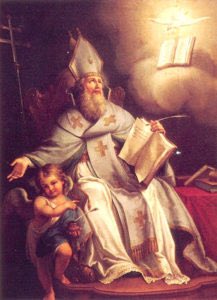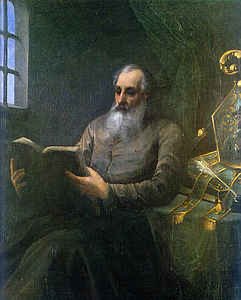Born in Caesarea in 348 AD into the family of St. Nerses, St. Sahak Partev became the last catholicos to descend from the lineage of St. Gregory the Illuminator.
With the partition of Armenia in 387 AD by the Byzantines and Sassanids, the western half became part of the Byzantines known as Byzantine Armenia, while the eastern (and much larger half) became a vassal state within the Sassanid realm.
St. Sahak Partev became the Catholicos of all Armenians in 389 AD, and the invention of the Armenian alphabet itself emerged from the need to hold the two halves of Armenia together.
At the time of St. Sahak’s birth in 348 AD, Armenia was already used to its status as the crossroads and borderland between the Persian and Byzantine empires. The rulers who followed Zoroastrianism tried to suppress the national and religious identity of the Armenian people.
Christianity turned out to be the only real force that contributed to the self-assertion of the Armenian culture. But for its strengthening, Armenians needed to have the Holy Scriptures in their native language.
As Catholicos, he supported the work of St. Mesrop Mashtots in the creation of the Armenian alphabet, a system of writing, and the translation of the Bible into Armenian. A scholar and theologian himself, he is counted among the Holy Translators.
The trio of King Vramshabouh, Catholicos Sahak, and Mesrop Mashtots together oversaw the flurry of translations into Armenian and an emergent new Armenian-language literature followed after the invention of the alphabet in 405 AD.
The Armenian alphabet and the translations were based on Assyrian and Greek manuscripts which were delivered to Armenia by special envoys of Sahak. Various scripts have been credited with being the prototype for the Armenian alphabet.
Pahlavi was the priestly script in Armenia before the introduction of Christianity, and Syriac, along with Greek, was one of the alphabets of Christian scripture. Armenian shows some similarities to both (Greek and Syriac).
However, the general consensus is that Armenian is modeled after the Greek alphabet, supplemented with letters from a different source or sources for Armenian sounds not found in Greek.
Following the creation of the Armenian alphabet, St. Sahak and St. Mesrop opened a school for translators in the city of Vagharshapat (Etchmiadzin). There they begin the translation of the Holy Bible into Armenian and did it so perfectly, that centuries hence...
The Armenian Translation is called the “Queen Translation of the Breath of God.” The first sentence translated from the Holy Bible is the opening verse of the Book of Proverbs:
“To know wisdom and instruction, to perceive the words of understanding.”
“To know wisdom and instruction, to perceive the words of understanding.”
Creating the Armenian alphabet and launching an Armenian literature and liturgical tradition helped to hold both the Armenian Church and the Armenian people together. St. Sahak oversaw and participated in this work. From that time, Armenian literature’s rapid development began.
For his deeds aimed at ensuring the preservation of the Armenian identity, the Armenian Church remembers Sahak Partev as one of its greatest saints. Churches are often named “St. Sahak and Mesrob” in acknowledgment of the crucial work these two men did together.

 Read on Twitter
Read on Twitter



